Effects of interior ballistic factors on dispersion of central blast tube cluster munitions
YUAN Li-dong, WANG Zhi-jun, WU Guo-dong
(College of Mechatronic Engineering, North University of China, Taiyuan 030051, China)
Effects of interior ballistic factors on dispersion of central blast tube cluster munitions
YUAN Li-dong, WANG Zhi-jun, WU Guo-dong
(CollegeofMechatronicEngineering,NorthUniversityofChina,Taiyuan030051,China)
This article uses nonlinear dynamics analysis software AUTODYN-2D to establish an interior ballistic model of central blast tube cluster munitions dispersion. The interior ballistic process of the central blast tube cluster munitions dispersion was simulated. The state of submunitions dispersion was obtained as interior ballistic conditions changed. The effect of shell stress groove on shell opening was discussed. The shell with stree groove is helpful for submunitions dispensing effectively and uniformly. The effect of liner material on submunitions dispersing was discussed. It can be found that foam liner can reduce the interior ballistic pressure, increase the pressure action time, reduce the acceleration of the submunitions and increase the submunitions dispersing velocity. These results provide some reference for the theory and experiment research of the central blast tube cluster munitions dispersion.
cluster munitions; interior ballistics; AUTODYN
0 Introduction
Cluster munition technology is an important conventional weapon technology because the submunitions can greatly extend the damage range to the target as well as the munition itself has smaller mass and can carry a lot of submunitions[1]. Dispersion technology has important influence on submunitions damage range and destructive power[2]. The central blast tube dispersion technology has advantages of simple structure, reliable action and high dispersing velocity, but the impact overload of the submunitions is so great that acceleration is up to tens of thousands to hundreds of thousands of g. At present, the central blast tube dispersion technology is mainly used in the fragmentation-blast cluster munitionss with thicker sheel. For example, the anti-airport runway penetrating blast cluster ammunitions use explosion dispersion technology and the overload reaches tens of thousands of g. But for the anti-armor submunitions with thinner shell, they produce serious deformation after dispersion. The penetration power is also significantly reduced[3]. How to reduce the overload of submunitions has become one of the most important research topic on cluster munitions. The interior ballistic technology of cluster munitions is an important part of the cluster munitions technology. Its action process has great effect on the motion of submunitions[4-5], In this process, action time is short, the mechanical environment is complex, theoretical analysis becomes very difficult and there exist certain limitations for experimental study. Therefore, numerical simulation is really a kind of important means to solve this kind of problem[6].
In this paper, based on the existing research results, an interior ballistic model of the central blast tube cluster munitions dispersion is established by nonlinear dynamic analysis software AUTODYN-2D, and the effect of the structure on the motion state of the submunitions is analyzed by numerical simulation. In order to maintain the advantages of the central blast tube cluster munitions dispersion and reduce the overload of the submunitions, by changing the shell with slots and using semi hard polyurethane foam plastic and nylon plastic as liner materials, respectively. Under the different conditions, submunitions dispersing velocity, submunitions overload, curve of interior ballistic pressure change with time as well as the submunitions dispersion state is obtained, which can provide reference for cluster munitions theoretical and experimental study[7].
1 Computational model
1.1 Geometric model
The interior ballistic model of central blast tube cluster munitions is mainly composed of shell, eight submunitions, liner and TNT. Its structure is shown in Fig.1. The cluster munitions diameterDis 150 mm, TNT charge diameterdis 16 mm, liner thicknessHis 24 mm, shell thicknesshis 3.5 mm, and submunition radiusris 19.6 mm.

Fig.1 Interior ballistic structure of cluster munitions
1.2 Material constitutive model, parameters and finite element model
For shell material, V250 steel, “Shock” state equation and strength model “Geometric Strain” criterion are selected; For submunition materials, 4340 steel, “Linear” state equation and elastic plastic strength model “Johnson Cook” criterion are adopted; For polyurthane foam, POLYURETH material model, “Linear state” equation and strength model “Geometric Strain” criterion are used; For nylon plastic, NYLON material model, “Shock” state equation, intensity model “Geometric Strain” criterion are employed; For power source, TNT material model and JWL state equation are adopted. The above materials are selected from the AUTODUN material library. The detonating mode is center-point initiation mode. Because the central blast tube cluster munitions dispersion process is complex, including interior ballistic pressure, liner deformation, munitions openning the shell, interior submunitions explosion driving process and detonation wave propagation, it is difficult to solve the problems using single Euler or Lagrange algorithm. Therefore, Euler-Lagrange algorithm is used (unit: mm-mg-ms-KPa).
According to the structure diagram, the discrete model of the shell is established by TureGrid software, then processed to form zon file and imported to AUTODYN program. In order to improve the efficiency of simulation calculation and illustrate the problem, AUTODYN-2D calculation model is adopted and the finite element model is shown in Fig.2.
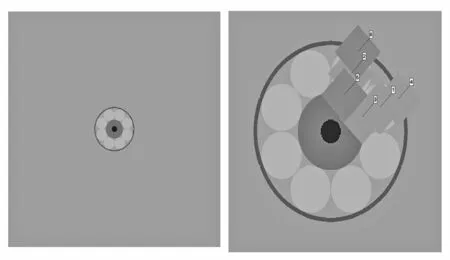
Fig.2 Numerical simulation finite element model
2 Simulation results and analysis
2.1 Effect of shell stress groove on submunitions dispersion
In order to study the effect of shell stress groove on submunitions dispersion, eight stress grooves are machined on the outer surface of the shell to which the submunitions is tangent. Groove position, shape and depth determine fragmentation degree of the shell. The shape and position of stress groove are shown in Fig.3.
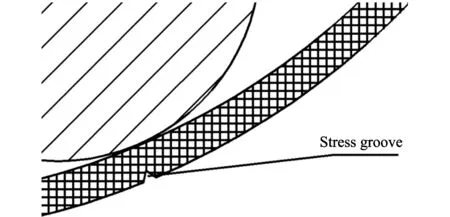
Fig.3 Shell stress groove
The interior ballistic processes with stress groove and without stress groove are simulated. The change process is shown in Fig.4.
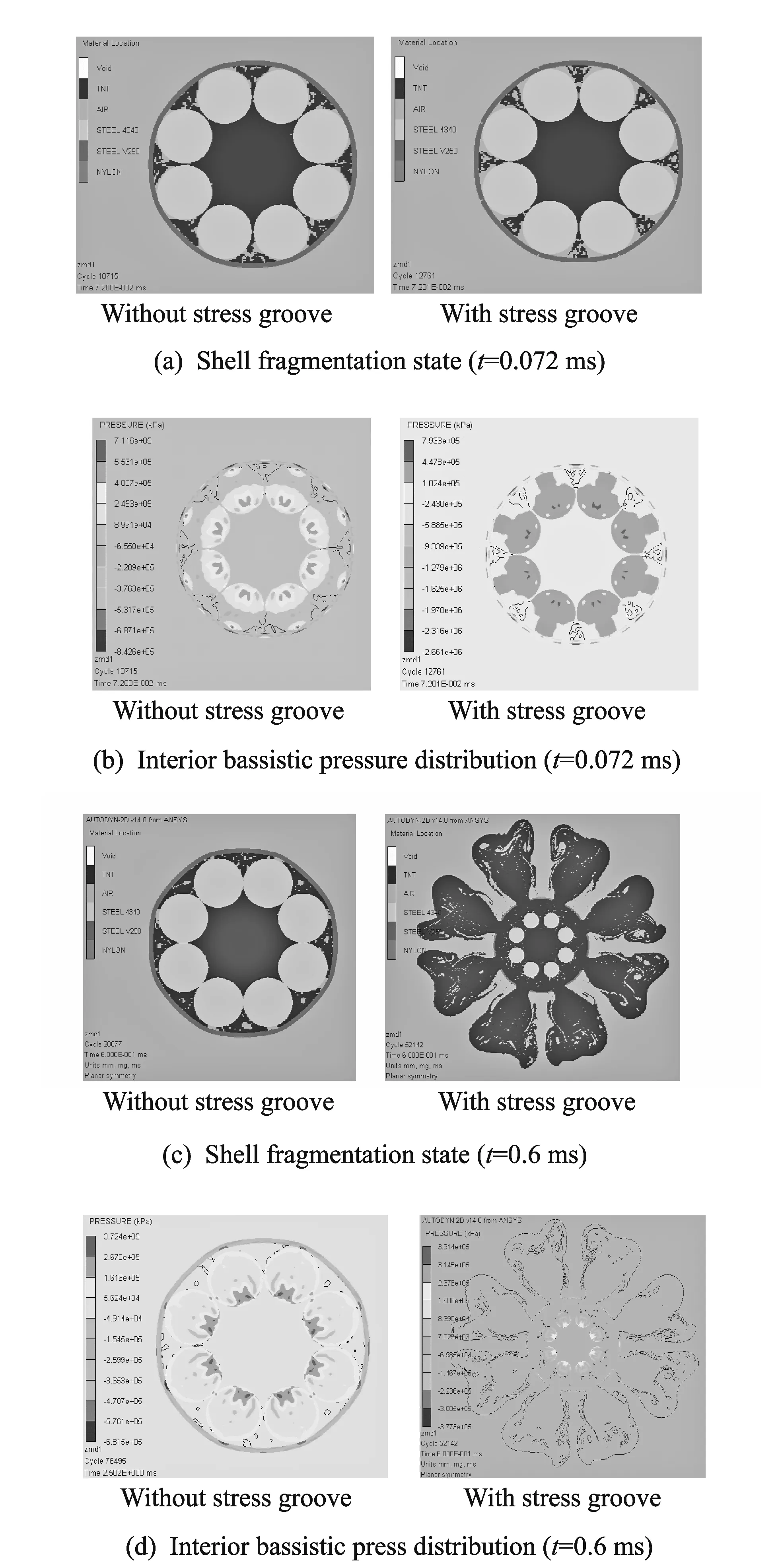
Fig.4 Interior ballistic state change
As Fig.4 shows, att=0.072 ms, there is little difference between the internal ballistic pressures with stress groove and without stress groove. But the shell with stress groove has a crack along the stress groove, while the shell without stress groove does not change significantly. Att=0.6 ms, the shell without stress groove is not broken, as a result, the interior ballistic is under high pressure. However, the shell with stress groove has been broken along the stress groove, thus the interior ballistic pressure becomes very small and submunitions is uniformly and effectively dispersed, as shown in Fig.5.

Fig.5 Distribution of submunitions (t=0.6 ms)
As Fig.6 shows, att=2.5 ms, the shell without stress groove is still is not broken, which means that in this case it cannot produce damage effect; but under the same circumstances, the shell with stress groove is broken att=0.072 ms and submunitions is uniformly dispersed, thus better dispersing effect is achieved and the interior ballistic pressure is greatly reduced, which is good for safety protection for the submunitions. In Fig.4, the interior ballistic pressure distribution att=0.075 ms shows that stress groove causes stress concentration at the stress groove of the shell, which results in the shell broken as soon as possible, reduces interior ballistic pressure and action time, and prevents the destruction of the submunitions.
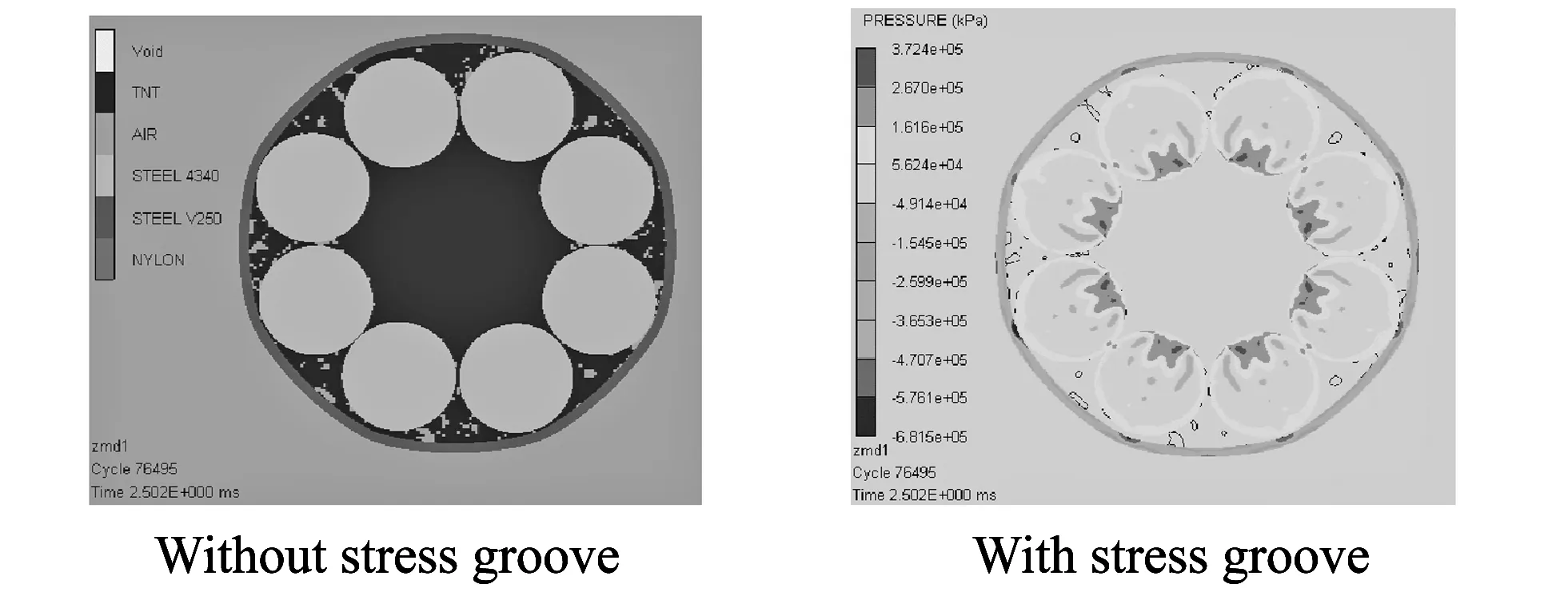
Fig.6 Interior ballistic pressure distribution without stress groove (t=2.5 ms)
If two shells are identical, fragmentation stress are the same. In the interior ballistic process, interior ballistic pressure increases with the increase of fuel combustion, the pressure of the submunitions and the shell is increasing until the shell is broken. After stress grooves are machined on the outer surface of the shell to which the submunitions is tangent, the shell becomes thinner and the fragmentation stress decreases. Under the extrusion of submunitionss, the shell produces stress concentration at the stress groove, thus the shell is quickly broken. Consequently, the interior ballistic pressure, submunitions pressure and acceleration reduce, which prevents the submunitions from the destruction due to the failure of the shell wall of the submunitions.
2.2 Effect of nylon plastic and semi rigid polyurethane foam as liner materials on interior ballistics of cluster munitions
Under the same conditions, nylon plastic and semi rigid polyurethane foam are used as liner materials of the cluster ammunitions in the process of internal ballistic simulation analysis. Gauss point is established in the center-of-mass of the submunitions to obtain submunitions dispersion velocity, as shown in Fig.7.

Fig.7 Submunitions velocity change
In the interior ballistic process, the closer the distances from the interior ballistic center is, the bigger the pressure is. In order to study the stress on submunitions in the interior ballistic process, Gauss point is set in the contact point of the submunitions and liners surface, the pressure change of the submunitions is shown in Fig.8.
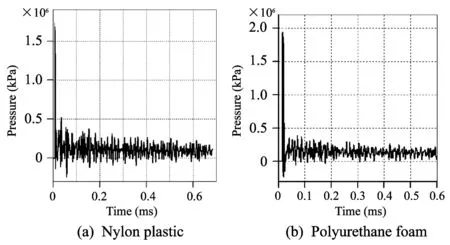
Fig.8 Pressure change of submunitions
As shown in Fig.7, the dispersing velocity of the submunitions using nylon liner can reach 32 m/s, while the dispersing velocity using polyurethane can reach 25 m/s. As shown in Fig.8, in the above two cases, the pressure of the submunitions surface is about 200 MPa except for the moment of impact. The submunitions are not easy to fail if the pressure is smaller and pressure time is shorter.
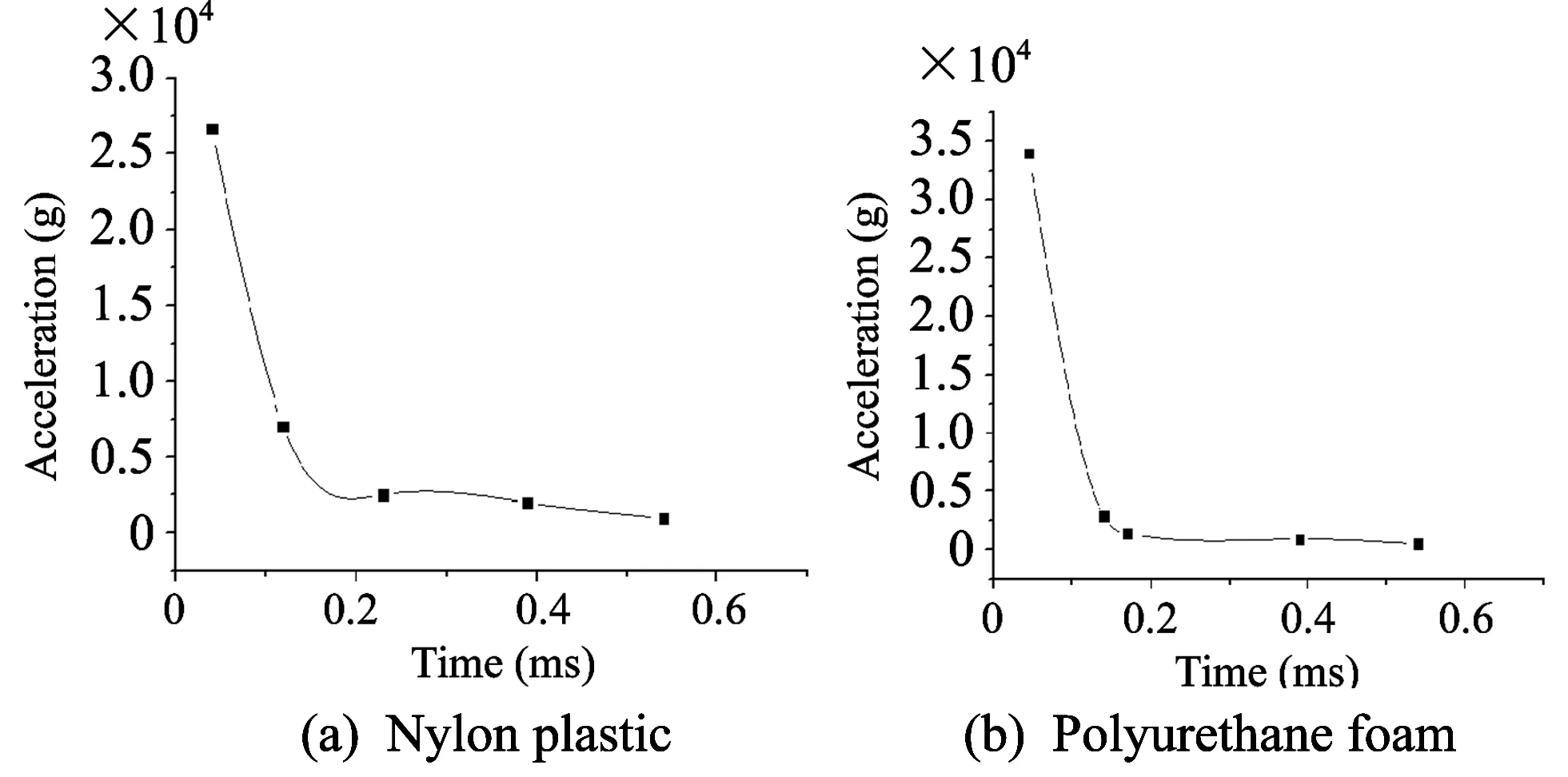
Fig.9 Submunitions overload change
As shown in Fig.9, using nylon liner, the maximum submunitions overload is 26 670 g. In most of interior ballistic process, the submunitions overload keeps around 2 500 g, below 10 000 g. While using polyurethane liner, the maximum submunitions overload is 34 000 g. In most of interior ballistic process, the submunitions overload remains about 2 000 g, blow 100 000 g. For the central blast tube cluster munitions, submunitions overload is usually very big. Nylon plastic and polyurethane foam are respectively used as liner materials to keep the submunitions overload being small because the liners of these materials not only have the effects of sound-absorbing, fixing submunitions and explosive charge, but also have the effect of shock absorption. Under blast loading, the pressure of the submunitions is reduced and the pressure time is increased. Finally, submunitions reach higher muzzle velocity and lower overload under lower pressure.
2.3 Result analysis
Using nylon and polyurethane foam as the liner materials liner deformations with time are shown in Figs.10 and 11, respectively.
In interior ballistic process, deformation of nylon liner is larger and its burning part is more during the same period because under the action of high temperature and high pressure, nylon liner is softer and easier to burn than the polyurethane foam liner. Nylon liner has better buffering effect, which can increase the action time and reduce the submunitions overload in the interior ballistic process. Finally, higher dispersing velocity is obtained.

Fig.10 Nylon liner deformation with time
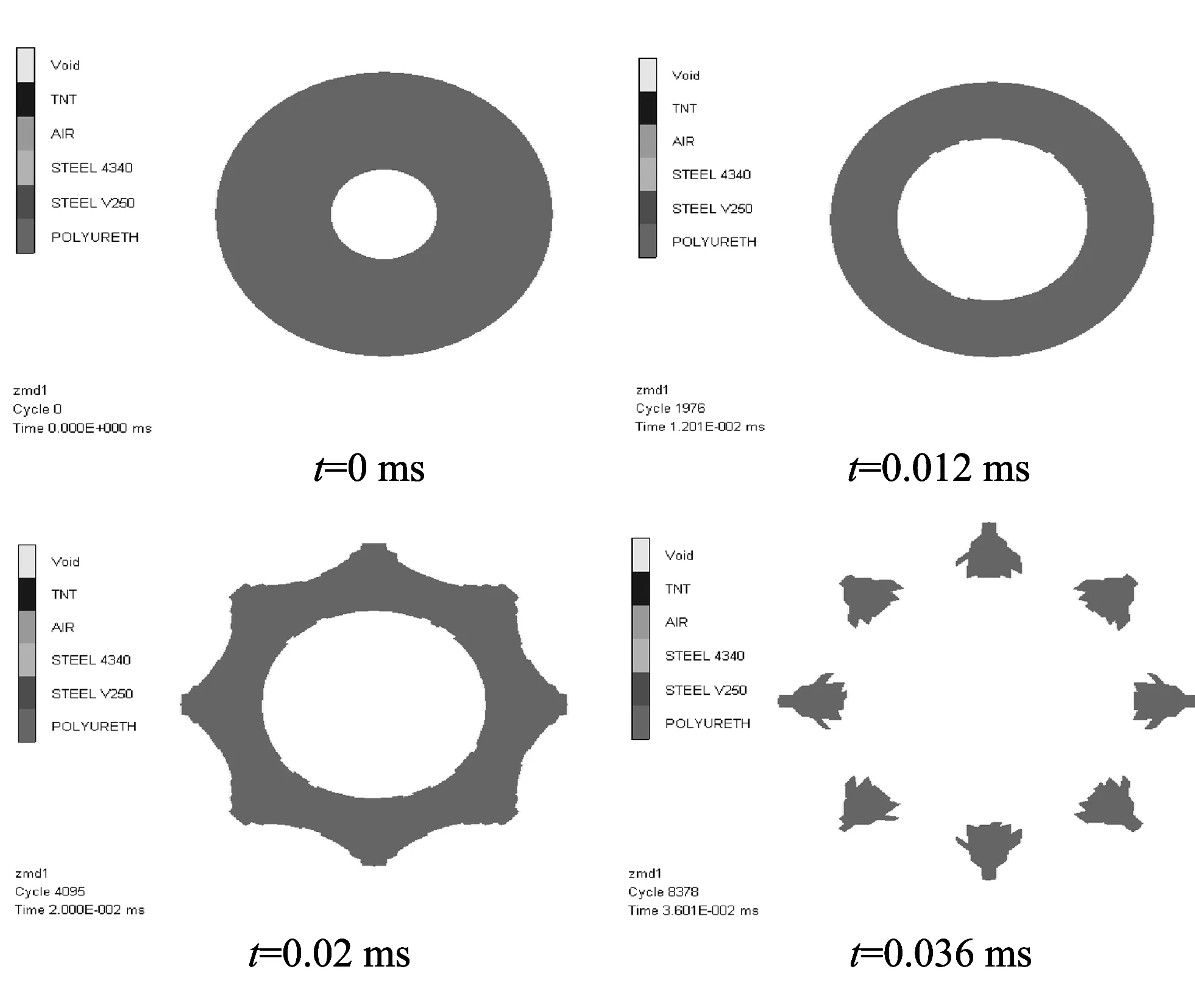
Fig.11 Polyurethane liner deformation with time
3 Conclusions
This article establishes a cluster ammunitions interior ballistic model by AUTODYN-2D. Submunitions dispersion is simulated and analyzed respectively in situations of without shell stress groove, with shell stress groove, semi hard polyurethane foam liner and nylon plastic liner.The following conclusions are obtained.
1) The shell stress groove makes the dispersion more easy and uniform because in the interior ballistic process, stress concentration in the shell stress groove forms weak strength areas. The shell is broken at the same time in the stress grooves. The submunitions achieves good dispersing effect.
2) Because the submunitions overload of the central blast tube cluster ammunitions is great, nylon plastic and polyurethane foam as liner materials can reduce the submunitions pressure and overload.
3) Under the condition of high temperature and pressure, nylon liner is softer and easier to burn compared with polyurethane liner. In the interior ballistic process, it has better effect of buffering the pressure acting on the submunitions, increasing action time and reducing the submunitions overload, finally achieving higher dispersing velocity.
[1]WANG Hao. Cluster center tube cluster munitions model and its application. Acta Armamentarii, 1998, 19 (4): 301-305.
[2]ZHANG Ke. Study on the technology of the cluster munitions. Master dissertation. Nanjing: Nanjing University of Science and Technology, 2013: 6-11.
[3]WANG Shuai. Experimental and simulation study on the explosive cluster warhead dispersion system. Doctoral dissertation. Nanjing: Nanjing University of Science and Technology, 2013: 11-15.
[4]CAI Xing-hui, WANG Shao-long, SUN Li-xin. Theoretical calculation model of the cluster munitions interior ballistic. Aerospace Shanghai, 2000, (6): 5-9.
[5]CONG Long-teng, JIANG Chao, LU Xiao-guang, et al. Study on the internal ballistic trajectory of compressed air based on AUTODYN. Aviation Weapon, 2014, (5): 46-49.
[6]ZHANG Wen-xu, ZHANG Jing, QI Zhan-yuan, et al. Cluster munitions interior ballistic modeling and simulation. Acta Armamentarii, 2006, (5): 797-801.
[7]JIN Zhi-ming. Modern interior ballistics. Bejing: Beijing Institute of Technology Press, 1983: 1-150.
内弹道因素对中心爆管子母弹抛撒的影响
袁利东, 王志军, 吴国东
(中北大学 机电工程学院, 山西 太原 030051)
利用非线性动力学分析软件AUTODYN-2D建立了子母弹中心爆管抛撒内弹道模型, 并对该中心爆管子母弹抛撒内弹道过程进行了数值模拟, 得到了在不同内弹道条件下子弹抛撒情况。 定性分析了壳体应力槽对壳体的影响, 相对于没有应力槽的壳体, 带有应力槽的壳体可以降低子弹所受压力, 有助于子弹均匀有效抛撒。 探讨了衬管材料对子弹抛撒的影响, 半硬质聚氨酯泡沫塑料、 尼龙塑料可以缓冲内弹道压力, 增加压力作用时间, 从而降低子弹过载, 提高子弹抛撒速度。 仿真结果为中心爆管子母弹抛撒理论和实验研究提供了依据。
子母弹; 内弹道; AUTODYN
YUAN Li-dong, WANG Zhi-jun, WU Guo-dong. Effects of interior ballistic factors on dispersion of central blast tube cluster munitions. Journal of Measurement Science and Instrumentation, 2015, 6(4): 336-341.
10.3969/j.issn.1674-8042.2015.04.006
YUAN Li-dong (1139612284@qq.com)
1674-8042(2015)04-0336-06 doi: 10.3969/j.issn.1674-8042.2015.04.006
Received date: 2015-08-31
CLD number: TJ760 Document code: A
 Journal of Measurement Science and Instrumentation2015年4期
Journal of Measurement Science and Instrumentation2015年4期
- Journal of Measurement Science and Instrumentation的其它文章
- Sensors layout optimization in explosion overpressure field reconstruction
- Instantaneous rotation speed measurement and error analysis for variable speed hydraulic system
- Experimental study on gas explosion to kill and injury mouse
- Fault diagnosis and analysis of main sea water pump based on vibration monitoring in offshore oil field
- Uncertainty contribution at NIS phototherapy irradiance facility
- Symmetric axis detection for images based on Hough algorithm
